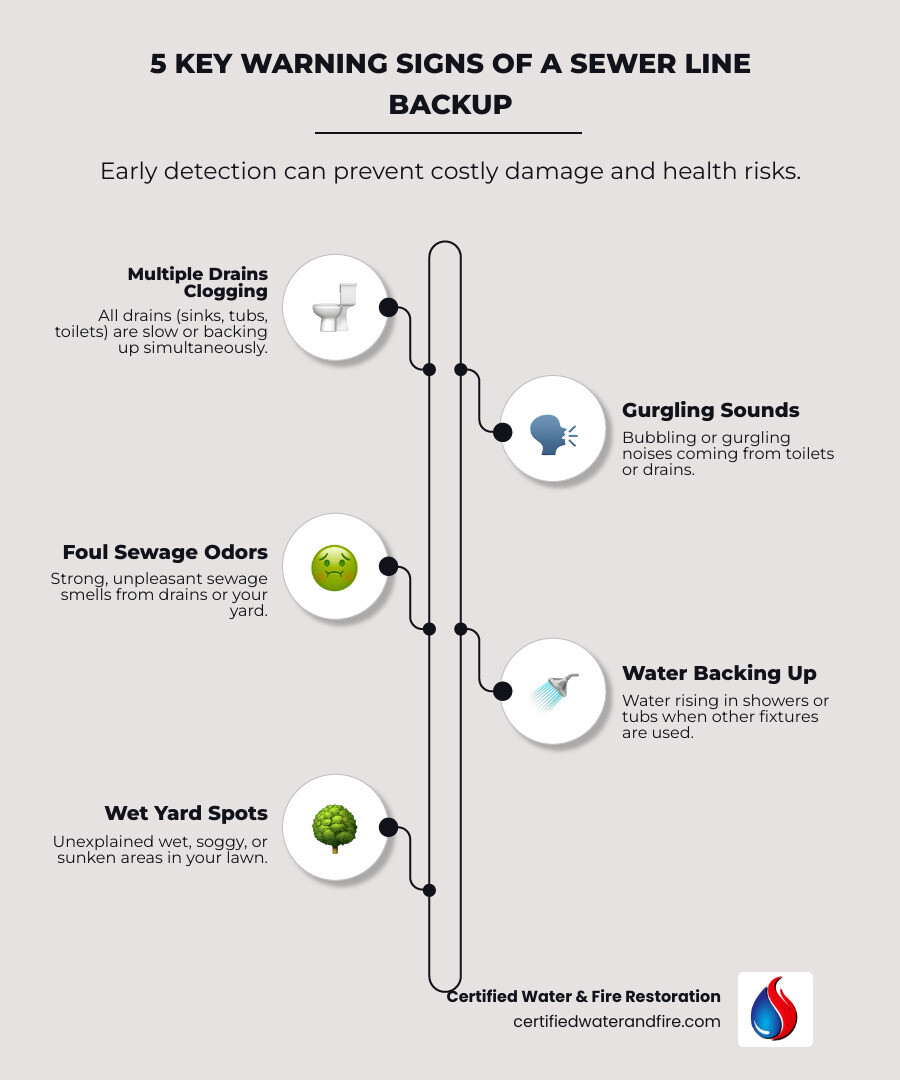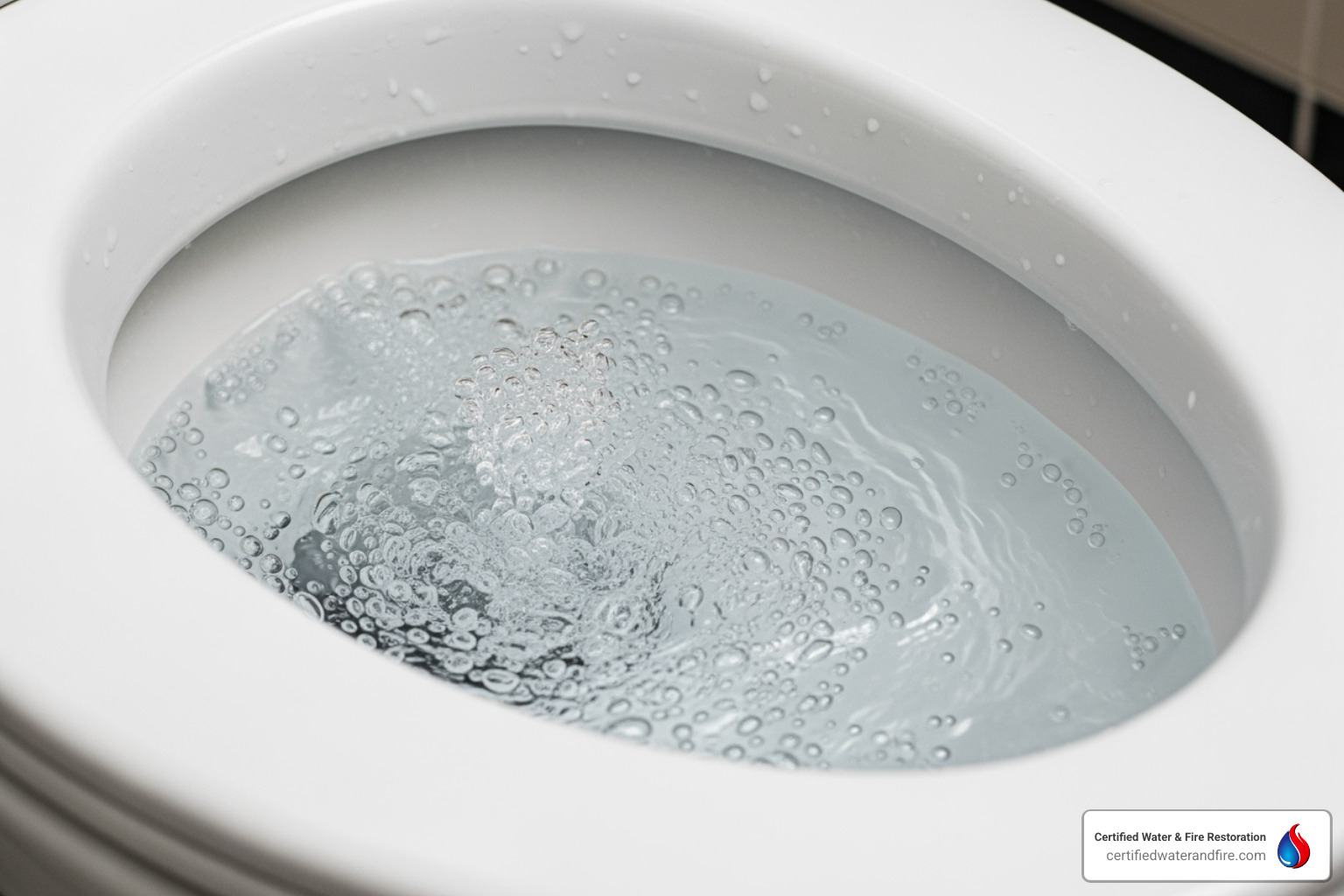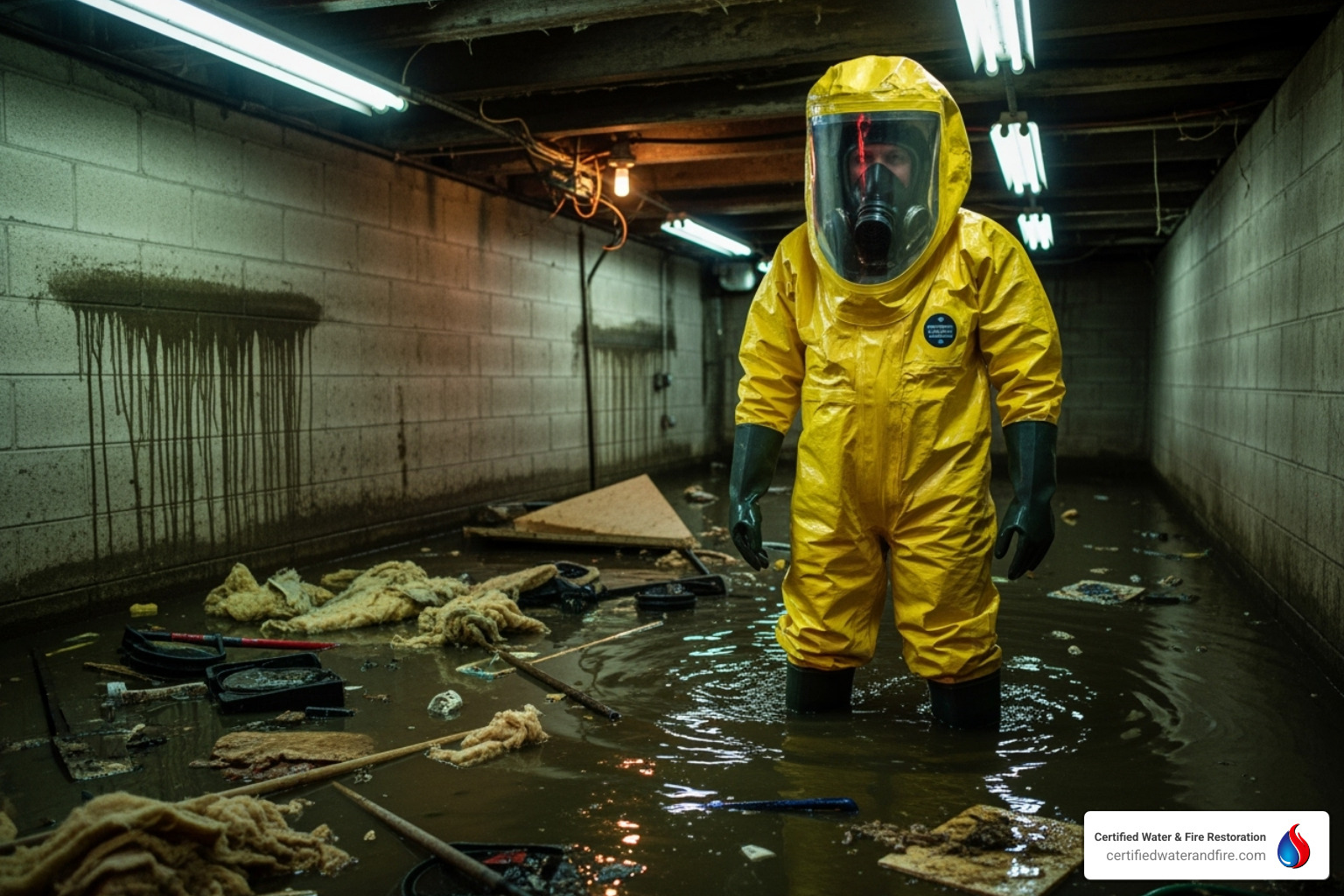Sewer Line Backup: 5 Ways to Prevent Disaster
The Unwelcome Intruder in Your Home
A sewer line backup is when wastewater flows back into your home instead of draining away. Blockages or damage in the sewer line prevent proper flow, causing sewage to surge out of drains, sinks, and toilets, damaging your property and creating a serious health hazard.
Quick Answer: Understanding Sewer Line Backups
- What it is: Wastewater reversing flow back into your home through drains.
- Why it happens: Blockages (grease, wipes, tree roots), aging pipes, heavy rainfall, or damaged sewer lines.
- Warning signs: Foul odors, slow drains, gurgling sounds, multiple fixtures backing up.
- Health risk: Category 3 water damage (blackwater) containing harmful bacteria and pathogens like E. coli and Hepatitis A.
- Average cost: $2,700 to $6,000+ for repairs, potentially over $10,000 for severe cases.
- Prevention: Proper waste disposal, regular inspections, and avoiding grease in drains.
This isn’t just an inconvenience—it’s a health hazard. Raw sewage contains bacteria, viruses, and parasites that can cause serious illness. The contaminated water can also lead to significant structural damage, including mold growth and ruined flooring.
Aging infrastructure makes this problem increasingly common. The U.S. has over 500,000 miles of sewer systems, many of which are decades old. It’s also important to know who is responsible: you own and maintain the sewer lateral (the pipe from your home to the city’s main line). If a backup occurs in the lateral, the repair is your expense.
I’m Ryan Majewski, General Manager of Certified Water & Fire Restoration. With over a decade of experience helping homeowners in Dallas and Houston recover from property damage, I’ve seen how quickly these situations escalate and how prevention can save thousands.

Is Your Sewer Line Backing Up? Early Warning Signs and Types
Catching a sewer line backup early can save you thousands of dollars and prevent serious health hazards. The difference between a minor plumbing call and a full-scale sewage disaster often comes down to recognizing these warning signs:
- Strong Sewage Smell: A foul odor from your drains or yard is a clear red flag that something is wrong.
- Multiple Slow Drains: If your kitchen sink, bathroom tub, and shower all drain slowly at the same time, the problem is likely in your main sewer line.
- Water Backing Up: Does flushing a toilet cause water to appear in your shower? This indicates a blockage is forcing wastewater to find new escape routes.
- Gurgling Sounds: Hearing a “glug-glug” sound from drains or toilets means air is trapped in the pipes, struggling to get past a blockage.
- Unusual Wet Spots: Soggy patches or unusually green grass in your yard near the sewer line can indicate a leak or break underground.

Main Line vs. Secondary Line Backups
Not all backups are the same. Understanding the difference helps determine the severity and cost of the fix.
- A main line backup affects your entire home. It’s a serious issue in the large pipe connecting your house to the municipal sewer, often causing water to back up in the lowest points of your home, like a basement drain. This requires immediate professional help.
- A secondary line backup is localized to a single fixture, like a sink or toilet. The clog is in a smaller branch pipe and is generally less severe and easier to fix.
| Feature | Main Line Backup | Secondary Line Backup |
|---|---|---|
| Affected Fixtures | Multiple drains and fixtures throughout the house, starting with lowest-level drains (basement floor drain, first-floor toilet). | Only one specific fixture (single sink, toilet, or shower). |
| Location of Clog | Main sewer pipe connecting your home to the municipal sewer system. | Smaller branch line serving a single fixture or one area of your home. |
| Severity | More severe, causing widespread backups and potentially involving city sewer issues. | Less severe, usually a localized clog. |
| Responsibility | Can be homeowner’s responsibility (lateral line) or city’s responsibility (main sewer line). | Always homeowner’s responsibility. |
| Typical Fix | Requires professional intervention like hydro-jetting or pipe repair, possibly city coordination. | Often cleared with a plunger, drain snake, or professional drain cleaning. |
| Common Causes | Tree roots, collapsed pipes, municipal sewer issues, major blockages. | Hair, grease, small objects, food debris. |
The key difference? Main line backups require immediate professional attention. If you notice several of the warning signs happening at once, don’t wait—call a professional plumber before you’re dealing with sewage on your floor.
The Root of the Problem: Common Causes of a Sewer Line Backup
A sewer line backup is often caused by a combination of factors. Some are preventable, while others relate to aging infrastructure. Many homes built before the 1970s have clay or cast iron pipes that corrode and crack over time, creating conditions for a backup.
The city handles the main sewer line under the street, but you’re responsible for the lateral line—the pipe running from your home to the city’s main. When problems occur in that lateral line, the repair costs are yours.

Blockages from Inside Your Home
Most backups originating inside the home are preventable. They happen when drains are treated improperly.
- Grease and Oil: Pouring grease down the drain seems harmless, but it solidifies in pipes, creating a sticky coating that traps debris and chokes off flow.
- “Flushable” Wipes: Despite the name, these wipes don’t break down like toilet paper. They accumulate and create stubborn clogs, a point emphasized by campaigns like Houston’s Protect Our Pipes.
- Paper Products & Hygiene Items: Paper towels and feminine hygiene products are designed to absorb water and stay intact, making them a primary cause of blockages.
- Food Waste: Large quantities of food, especially fibrous items like potato peels or coffee grounds, can build up and cause a blockage.
- Foreign Objects: Small toys or other items accidentally flushed down a toilet can easily lodge in pipes.
External Forces Damaging Your Pipes
Sometimes, the problem comes from outside your home.
- Tree Root Infiltration: This is the most common external cause. Tree roots seek water and can invade pipes through tiny cracks, growing into dense masses that block flow and break the pipe.
- Broken or Cracked Pipes: Shifting ground, heavy construction, or temperature changes can cause pipes to crack or collapse, allowing soil and debris to enter and create blockages.
- Sagging Sewer Lines: A section of the pipe can sink over time, creating a “belly” where waste and water collect, eventually causing a complete blockage.
- Heavy Rainfall: Intense rain can overwhelm the municipal sewer system, causing pressure to build and force wastewater back into homes, usually through the lowest drains.
- Municipal Sewer Main Issues: A blockage or collapse in the city’s main line can cause backups in multiple homes. If your neighbors have the same issue, this is likely the cause, and the city is responsible for the repair.
Emergency Response: What to Do Immediately When a Backup Occurs
When sewage backs up into your home, your immediate actions can prevent a manageable situation from becoming a catastrophe. Follow these steps:
- Stop Using Water Immediately: Do not flush toilets, run faucets, or use any water-based appliances. Every drop you add will worsen the flooding.
- Turn Off the Electricity: If water is near electrical outlets or appliances, shut off power to affected areas at the main panel to prevent a deadly electrocution risk.
- Avoid All Contact with Sewage: Keep children, pets, and yourself away from the contaminated water. It is a serious health hazard.
- Ventilate the Area: If you can do so safely, open windows to help dissipate toxic fumes and odors.
- Call a Professional Plumber: This is not a DIY job. A qualified plumber has the tools to diagnose and fix the problem. Our team at Certified Water & Fire Restoration offers 24/7 emergency service in Dallas and Houston, typically arriving within 60 minutes.
Health Risks and Safety Precautions
A sewer line backup is classified as Category 3 water damage, or “blackwater,” the most severe level of contamination. Raw sewage is a toxic mix of bacteria, viruses, and parasites like E. coli, Salmonella, and Hepatitis A. According to the Centers for Disease Control, these pathogens can cause severe illness.
Attempting a DIY cleanup is dangerous. Professionals use full personal protective equipment (PPE) for a reason. Without it, you risk serious health consequences.

If sewage has flooded living areas or soaked into drywall, the home may be uninhabitable until professional restoration is complete. The contamination and rapid mold growth (within 24-48 hours) make it unsafe. Temporarily relocating your family is often the safest choice.
Documenting Damage and Next Steps
After calling for help, focus on documentation for your insurance claim.
- Take Photos and Videos: Capture wide shots and close-ups of all damage. Your phone’s timestamp will prove when the damage occurred.
- Protect Undamaged Property: If you can do so safely, move valuables and important items to unaffected areas.
- Contact Your Insurance Company: Notify your insurer as soon as possible, ideally within 24 hours. Ask specifically about your coverage for sewer backups, as it often requires a special add-on.
For more on what professionals look for, see our guide on Water Damage Assessment. Professional restoration companies can help steer the claims process while making your home safe again.
Long-Term Prevention: How to Protect Your Home from Future Backups
No one wants to experience a sewer line backup twice. Fortunately, simple habits and smart investments can dramatically reduce your risk.
Start by being mindful of what goes down your drains. Never flush or pour these items:
- Grease, fats, and oils (cool and trash them)
- “Flushable” wipes (they don’t break down)
- Paper towels, tissues, and cotton balls
- Feminine hygiene products or diapers
- Dental floss, coffee grounds, or food scraps
Proper grease disposal is critical. Let it cool in a container, then throw it in the trash. Wiping greasy pans with a paper towel before washing also helps.
Consider a regular plumbing inspection every few years, especially if your home is older. A camera inspection can spot problems like tree roots or cracks before they cause a backup, saving you from costly emergency repairs.
Your landscaping choices also matter. Plant new trees and large shrubs away from sewer lines to prevent root intrusion. If you have mature trees nearby, consider professional root cutting every few years.
Mechanical and Structural Prevention Methods
For added protection, especially in high-risk areas, consider these mechanical solutions:
- Backwater Prevention Valves: These one-way gates allow wastewater to flow out but automatically shut if sewage tries to back up from the main line. This is one of the most effective preventive measures, as detailed in guides like this one on Sewer Backup Prevention Options for Homeowners.
- Floor Drain Plugs: A simple and affordable option for basement drains, these plugs create a seal to stop sewage from coming up.
- Sump Pumps: Essential for basements, sump pumps manage groundwater and help keep the area dry, which is a key part of your home’s overall water management.
- Overhead Sewer Systems: A more comprehensive solution for high-risk homes, this system pumps wastewater up and out to the sewer main, eliminating vulnerable below-grade drains. It’s a significant investment but offers the best peace of mind for homes with recurring backups.
Professional Solutions, Cleanup, and Insurance
After a sewer line backup, professional restoration is essential. DIY cleanup is not an option for Category 3 blackwater, which contains dangerous pathogens. Professional companies follow strict IICRC (Institute of Inspection, Cleaning and Restoration Certification) standards, using full protective gear and hospital-grade disinfectants to make your home safe.
The professional process includes:
- Water Extraction: Powerful, truck-mounted units remove standing sewage quickly to minimize damage and mold risk.
- Drying and Dehumidifying: Industrial air movers and dehumidifiers thoroughly dry all affected materials, including inside walls and under floors, a process that is monitored with moisture meters and is crucial for preventing mold. Our Ultimate Home Water Damage Guide details this process.
Professional Repair Options for a Sewer Line Backup
After cleanup, a plumber must fix the pipe itself. Modern technology offers several effective options.
- Video Camera Inspection: A high-resolution camera is fed through the line to pinpoint the exact cause and location of the problem without guesswork.
- Hydro-Jetting: High-pressure water (up to 4,000 PSI) blasts through clogs, cuts tree roots, and scours pipes clean.
- Pipe Relining (Trenchless Repair): A resin-coated liner is inserted into the old pipe, creating a new, seamless pipe inside the existing one with minimal digging.
- Pipe Bursting: Another trenchless method where a new pipe is pulled through the old one, breaking it apart and replacing it simultaneously.
- Full Excavation and Replacement: When pipes are collapsed or trenchless methods aren’t feasible, traditional digging is required to replace the damaged section of the sewer line.
Navigating Insurance for Sewer Backup Damage
Many homeowners are surprised to learn that standard homeowner’s policies do not cover sewer backup damage. This coverage is typically excluded and must be added separately.
A sewer backup endorsement or rider is an affordable add-on to your policy that specifically covers this type of damage. For a small annual fee, it can save you thousands in out-of-pocket costs.
This endorsement typically covers:
- Damage to your home’s structure (flooring, drywall).
- Damaged personal belongings.
- Professional cleanup and sanitization services.
- Temporary living expenses if your home is uninhabitable.
When filing a claim, provide thorough documentation, including photos and videos. At Certified Water & Fire Restoration, we work directly with your insurance company, handling the paperwork and billing them directly so you have no upfront costs. Learn more by reading our guide on Insurance Water Damage.
Frequently Asked Questions about Sewer Backups
After more than a decade of helping Texas homeowners with sewer line backups, we’ve found these three questions are the most common.
Who is responsible for the sewer line—the homeowner or the city?
You, the homeowner, are responsible for your sewer lateral. This is the pipe running from your house to the city’s main sewer line, even if it runs under the sidewalk. The city is only responsible for the main line, which is typically under the street. A plumber can determine if the blockage is in your lateral (your responsibility) or the city’s main. This is a common point of confusion, as clarified by resources like this one from DC Water.
How much does it cost to fix a sewer backup?
The cost varies widely, from a few hundred dollars for a simple clog to over $10,000 for a full pipe replacement. Most homeowners should expect to pay between $2,700 and $6,000. Key factors influencing the cost include the cause of the backup, the location of the problem, and the chosen repair method (e.g., trenchless vs. excavation). This price doesn’t include the cost of cleanup and restoration, which can add thousands more. Our guide on the cost to repair a water damaged house provides more detail on restoration expenses.
Can I live in a house during a sewer backup cleanup?
In most cases of a significant sewer line backup, the answer is no. Blackwater contamination poses serious health risks from bacteria and viruses. If sewage has spread into living areas, professional assessment will likely determine that the home is unsafe to occupy during the cleanup process. This is especially true for children, the elderly, or those with compromised immune systems. While inconvenient, temporary relocation is essential for your family’s health. Many insurance policies with a sewer backup endorsement will cover these additional living expenses.
Don’t Wait for a Disaste: Secure Your Home Today
We’ve covered the signs, causes, and solutions for a sewer line backup. Now, it’s time for action. Prevention is your best defense against thousands of dollars in damage and serious health risks. Simple habits like proper grease disposal and avoiding “flushable” wipes are your first line of defense.
When a backup does occur, time is critical. Every minute allows contaminated water to cause more damage. Raw sewage is Category 3 blackwater, a serious biohazard that requires professional handling to protect your family’s health.
This is where Certified Water & Fire Restoration comes in. We understand that emergencies don’t keep business hours.
- 24/7 Emergency Services: We are available day or night throughout Dallas and Houston.
- 60-Minute Response Time: We commit to being on-site quickly because we know every minute counts.
- No Upfront Costs: We work directly with your insurance company, handling the paperwork and billing so you don’t pay out of pocket.
- 2-Year Warranty: We stand behind our work, giving you peace of mind that the job is done right.
Whether you’re facing an active emergency or want to schedule a preventive inspection, we are ready to help. Don’t wait until you’re ankle-deep in sewage to take action.
For immediate, professional assistance, visit our Professional Sewage Damage Restoration Services page to learn how we can restore your home safely and completely.

